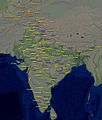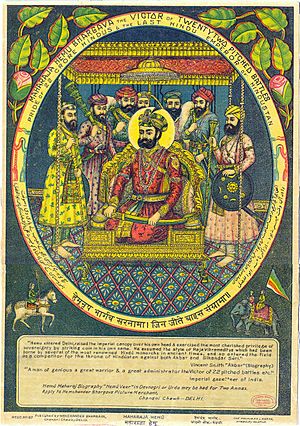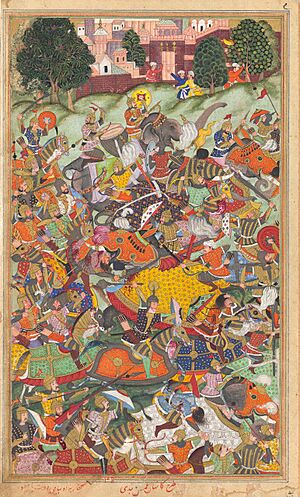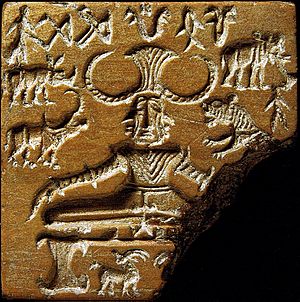History of Haryana facts for kids
Haryana is a state in India with a very long and interesting history. It's known as a "cradle of civilization" because many ancient sites from the Indus Valley Civilisation have been found here. In old Indian stories like the Mahabharata, Haryana was called the Bahudanayak Region.
Over many centuries, Haryana was ruled by different powerful groups. These included the Maurya Empire, Gupta Empire, Mughal Empire, and even the British Raj. Many important battles, like the famous Battles of Tarain and Panipat, happened in Haryana. After being part of the Punjab province for a long time, Haryana became its own separate state in India in 1966. Today, Chandigarh is the shared capital for both Punjab and Haryana.
Contents
- A Journey Through Time: Haryana's History
- Haryana's Key Features Today
- See also
- Images for kids
A Journey Through Time: Haryana's History
Ancient Times: Stone Age Discoveries
The story of people living in Haryana goes back a very long time, even 100,000 years ago! In 2021, archaeologists found ancient cave paintings and tools in the Mangar Bani hill forest. These paintings are thought to be some of the oldest in the world. Many other ancient sites were found in this area, including Anangpur and Surajkund.
Even older discoveries were made near Chandigarh. A British geologist named Guy Ellcock Pilgrim found 150,000-year-old human teeth and a jawbone in the Pinjore region. This shows that very early humans lived here during the Stone Age.
Early Civilizations: Indus Valley and Vedic Periods
Indus Valley Civilization: Life by the Rivers
The amazing Indus Valley Civilisation grew up along the banks of the Indus and Sarasvati rivers. The Sarasvati and its smaller river, the Drishadvati river (also called Ghaggar), flowed through northern and central Haryana. Because of this, many important Indus Valley Civilization sites are found in Haryana. Some famous ones include Rakhi Garhi, Banawali, and Bhirrana.
The Haryana government is working to bring the Saraswati river back to life. They have also built the Rakhigarhi Indus Valley Civilisation Museum to protect the ancient things found there.
Vedic Period: Kingdoms and Wisdom
During the Vedic era (around 1500 BCE to 6th century BCE), small kingdoms called janapadas existed in Haryana. These later grew into larger mahajanapadas. The Kuru janapada covered most of Haryana, and its area was known as Kurukshetra. This is the famous place where the great war of the Mahabharata is said to have happened.
It's also believed that Lord Krishna shared the wisdom of the Bhagavad Gita with Arjuna at a place called Jyotisar in Haryana. Many ancient texts describe the boundaries of Kurukshetra as being similar to modern-day Haryana.
Medieval History: Empires and Battles
Hindu-Buddhist Era: Powerful Kings
After the Huns were defeated, King Harshavardhana made Thanesar (near Kurukshetra) his capital in the 7th century CE. Later, the Pratiharas ruled a large area. In the 12th century, Prithviraj Chauhan built forts in places like Taraori and Hansi.
Sultanate Period: Delhi's Influence
Muhammad Ghori took control of Haryana after the Second Battle of Tarain. This led to the establishment of the Delhi Sultanate, which ruled much of India for centuries. The name 'Hariana' was first mentioned in a Sanskrit writing from 1328 AD. It called the region "The heaven on earth," showing it was a rich and peaceful place. Firuz Shah Tughlaq built a fort in Hisar in 1354 and also dug canals for water.
The Khanzadas of Mewat were a ruling family in the Mewat region until 1527.
Mughal Empire: The Panipat Battles
The famous Battles of Panipat took place near the modern town of Panipat.
- The first battle in 1526 saw Babur defeat Ibrahim Lodi, starting the Mughal Empire in India. Hasan Khan Mewati fought alongside Ibrahim Lodi against Babur.
- The Second Battle of Panipat in 1556 was fought between Akbar's army and Hemu, a local hero from Rewari in Haryana. Hemu was a very skilled leader who won 22 battles before this one. He even became king in Delhi for a short time. Sadly, he died in the Second Battle of Panipat.
Maratha Period: A Major Conflict
The Third Battle of Panipat was fought in 1761 between the Afghan ruler Ahmad Shah Abdali and the Maratha Empire. Ahmad Shah won this important battle.
British Rule and Independence
Colonial Period: The 1857 Rebellion
The Indian Rebellion of 1857 (also called the First War of Independence) started in Ambala Cantonment in Haryana, just hours before it began in Meerut. Soldiers revolted, but the rebellion was put down. Major centers of the rebellion in Haryana included Hisar, Rohtak, and Rewari.
Brave leaders from Haryana like Raja Nahar Singh of Ballabhgarh and Rao Tula Ram of Rewari played important roles. After the rebellion failed, Haryana was taken away from the North-Western Provinces and added to Punjab as a punishment.
Road to Independence and Formation of Haryana
Many people from Haryana joined the fight for India's freedom. Leaders like Lala Lajpat Rai worked for social reform and independence. Soldiers from Haryana also joined Subhas Chandra Bose's Azad Hind Fauj.
When India gained independence in 1947, there were many riots and people had to move between India and Pakistan.
On November 1, 1966, Haryana was created as a separate state from East Punjab. This happened because people in Haryana spoke Hindi, and they wanted their own state based on language. A special committee and commission were set up to decide the boundaries. Districts like Hisar, Mahendragarh, Gurgaon, Rohtak, and Karnal became part of the new state of Haryana.
Haryana's Key Features Today
Economy and Development
Modern Markets: India International Horticulture Market
Haryana is building a huge market called the India International Horticulture Market (IIHM) in Ganaur. It will be Asia's largest market for fruits, vegetables, and flowers, with many shops and specialized areas for cleaning, packing, and selling goods. This market will help farmers and businesses from 14 states.
Water for Life: Irrigation Systems
Haryana has a large network of canals to bring water to farms. It gets a share of water from the Yamuna and Sutlej rivers. There are also big dam projects like the Renukaji Dam, Lakhwar Dam, and Kishau Dam being built to help provide more water for irrigation and electricity. The government has also been working to restore ancient ponds called Johads and revive the Saraswati river.
Culture and Heritage
Ancient Art and Clothing
Archaeological finds from the Indus Valley Civilisation in Haryana, like those at Rakhigarhi, have shown us what people wore and the beautiful jewelry they had. We've found silver and bronze ornaments, and even seen how the famous "Dancing Girl" statue was adorned.
Languages and Arts
The main language spoken in Haryana is Haryanvi, which has different dialects. Haryana also has its own unique folk music and dance forms, like Swang. There are even movies made in Haryanvi!
Historical Buildings and Sites
Haryana has many ancient and historical buildings. These include temples from different periods, like the Bhima Devi Temple Site Museum and the Kalayat Ancient Bricks Temple Complex. You can also find Pillars of Ashoka in places like Topra Kalan and Hisar, which were moved from their original spots. Many old mansions called havelis with beautiful architecture can be seen in places like Nangal Sirohi.
Military and Sports Excellence
Haryana's Contribution to the Military
Haryana has a strong tradition of joining the military. It contributes a very high number of soldiers and officers to the Indian military compared to its population size. For example, Haryana, with only 2% of India's population, contributes about 11% of its soldiers. Villages like Bisahan are famous for having at least one person from every family in the military!
There are many important military bases in Haryana, including Ambala Cantonment and the National Security Guard (NSG) headquarters in Gurugram.
A Sporting Powerhouse
Haryana is often called "India's Olympian state" or "The Sports State of India" because its athletes win so many medals in international competitions. Even though Haryana has a small area and population, its athletes consistently win a large percentage of India's medals in the Olympics, Asian Games, and Commonwealth Games.
For example, in the Olympics, Haryana has won almost half of India's individual medals. In the 2022 Commonwealth Games, Haryana's athletes won 42% of India's individual medals! This success is due to the government's support, good training facilities, and the strong cultural interest in sports, especially wrestling, among the people of Haryana. Many young people from Haryana are inspired by their successful athletes and aim for gold themselves.
Travel and Connectivity
Airports and Aviation
Haryana has several airports and airstrips. The first airstrip was built in 1919 at Ambala Air Force Station. Other airports exist in Hisar, Karnal, and Narnaul. The Rajiv Gandhi National Centre for Aero Sports at Narnaul Airport offers training in exciting air sports like parasailing and hot air ballooning. The government is working to develop all these airports for larger aircraft and better facilities.
Roads and Railways
Haryana has a good network of roads and highways, including parts of the historic GT Road (Grand Trunk Road) with its old Kos Minar (mile markers) and caravanserais (rest stops). The state's railway system falls under two main zones of Indian Railways.
See also
- Divisions of Haryana
- History of Punjab
- History of India
- Timeline of Indian history
Images for kids











